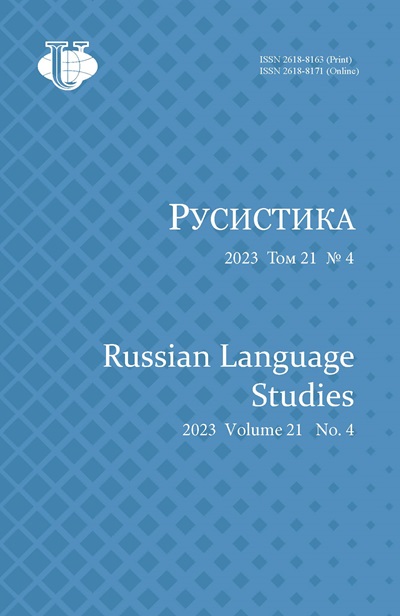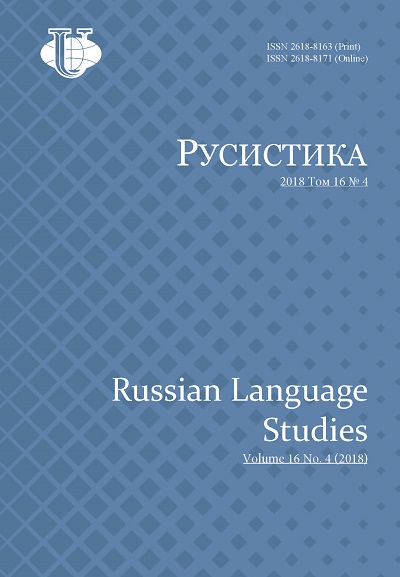The problems of linguoculturology discussed on the pages of the “Russian Language Studies” journal
- Authors: Guzman Tirado R.1
-
Affiliations:
- University of Granada (Universidad de Granada)
- Issue: Vol 16, No 4 (2018)
- Pages: 380-397
- Section: Review Article
- URL: https://journals.rudn.ru/russian-language-studies/article/view/20264
- DOI: https://doi.org/10.22363/2618-8163-2018-16-4-380-397
Cite item
Full Text
Abstract
The article presents a review of linguocultural materials published in recent years in the scientific journal “Russian Language Studies” (in the past it was called “The Bulletin of Peoples’ Friendship University of Russia. Series: Russian and Foreign Languages Research and Teaching”). The author concentrates on the concept of “linguoculturology”, its origin, development and the main approaches to its study. The analysis of the materials published in the journal makes it possible to focus on the articles dealing with the comparative, cognitive, applied linguoculturology, linguoculturology of ethnos and subethnos. The author underlines the importance of the linguocultural approach to the analysis of the significance of the cultural code, and the specific features of the national verbalization related to the vision of the world around the linguistic personality. A number of publications deal with applied linguoculturology that is somehow connected with the culture-oriented linguistics. The author believes that it is reasonable to use a linguocultural approach in the process of writing textbooks for bilingual students and in the study of linguistic units of different levels. Additionally, this approach can help researchers identify the place and role of the Russian language in linguoculturology. The author argues that the materials presented in the journal cover a wide range of linguocultural studies and enrich linguoculturology from the point of view of theory and practice.
About the authors
Rafael Guzman Tirado
University of Granada (Universidad de Granada)
Author for correspondence.
Email: rguzman@ugr.es
Doctor of Philology, Professor of the Department of Greek and Slavic Philology of the University of Granada. He is a member of MAPRYAL Presidium (International Association of Teachers of the Russian Language and Literature (Spain). He supervises the research group “Slavic Studies, Caucasus Studies and Typology of Languages”
Spain, Granada, 18010, Av. del HospicioReferences
- Alefirenko, N.F. (2010). Lingvokul’turologiya. Tsennostno-smyslovoe prostranstvo yazyka [Cultural Linguistic. Value-Semantic Space of Language]. Moscow: Flinta Publ.; Nauka Publ. (In Russ.)
- Avramova, V. (2007). Lingvokul’turologiya [Cultural Linguistic]. Shumen: Episkop Kontstantin Preslavski Publ. (In Russ.)
- Bel’chikov, Yu.A. (2009). Yazyk i kul’tura (materialy spetskursa) [Language and Culture (Special Course Materials)]. Moscow: MGU Publ. (In Russ.)
- Bobylyova, E.S. (2016). Linguocultural Analysis of Macrotoponyms in Chile. RUDN Journal of Russian and Foreign Languages Research and Teaching. 1, 61—67. (In Russ.)
- Buyanova, L.Y. (2017). Phraseology as a Cultural Cognition Code and Spiritual Heritage of Our Predecessors. RUDN Journal of Russian and Foreign Languages Research and Teaching. 15 (3), 285—298. (In Russ.)
- Cui Liwei. (2015). Linguistic Means of Linguistic and Cultural Image of China in Linguistic Culture of Far East Emigration. RUDN Journal of Russian and Foreign Languages Research and Teaching. 4, 112—119. (In Russ.)
- Cui Liwei. (2016). Non-Equivalent Words in the Image of China in Russian Emigrants’ Linguistic Culture. RUDN Journal of Russian and Foreign Languages Research and Teaching. 2, 80—88. (In Russ.)
- Fernandez Sanchez, Y.V. (2016). Particularities of Humour in Basque Linguoculture. RUDN Journal of Russian and Foreign Languages Research and Teaching. 1, 119—126. (In Russ.)
- Gorodetskaya, L.A. (2009). Lingvokul’tura i lingvokul’turnaya kompetentnost’ [Cultural Linguistic and Cultural Linguistic Competence]. Moscow: KDU Publ. (In Russ.)
- Gritsenko, A.N. (2015). Functional Types of Metaphors in Russian and English Sporting Discourse. RUDN Journal of Russian and Foreign Languages Research and Teaching. 1, 154—160. (In Russ.)
- Ibragim, V.F. (2015). Concept “FATE” in Russian and Arab Linguistic Cultures. RUDN Journal of Russian and Foreign Languages Research and Teaching. 1, 161—170. (In Russ.)
- Ipatova, G.N. & Serova, L.K. (2016). Cultural-Linguistic Approach to Creating Educational Materials for Bilingual Students. RUDN Journal of Russian and Foreign Languages Research and Teaching. 1, 14—20. (In Russ.)
- Karelova, M.A. (2015). Linguistic and Cultural Details with the Word “SNOW” in Russian Poems of 1941—1942. RUDN Journal of Russian and Foreign Languages Research and Teaching. 2, 46—50. (In Russ.)
- Koltsova, L.M., Kudryavtseva, T.Yu. & Churikov, S.A. (2015). Linguistic and Cultural Value of Archaisms and Historisms in Teaching Russian as a Foreign Language. RUDN Journal of Russian and Foreign Languages Research and Teaching. 4, 58—68. (In Russ.)
- Kornakova, E.S. (2017). National and Cultural Specifics of Soviet Reality and its Linguistic Reflection in E.A. Evtushenko’s Poetry. RUDN Journal of Russian and Foreign Languages Research and Teaching, 15(1), 103—112. (In Russ.)
- Krasnykh, V.V. (2002). Etnopsikholingvistika i lingvokul’turologiya [Ethnopsycholinguistics and Cultural Linguistic]. Moscow: Gnozis Publ. (In Russ.)
- Kudria, O.A. (2015). Lexico-Semantic Classification of English and Ukrainian Secondary Colour Terms: Linguoculturological Aspect. RUDN Journal of Russian and Foreign Languages Research and Teaching. 1, 53—59. (In Russ.)
- Kurguzenkova, Zh.V. (2015). Linguistic and Cultural Analysis of Gender Marked Phraseological Units of Phraseosemantic Group Designating Women of Easy Virtue. RUDN Journal of Russian and Foreign Languages Research and Teaching. 1, 60—66. (In Russ.)
- Kurguzenkova, Zh.V. (2016). Conceptualization of Feminine Beauty in English Cultural Worldview. RUDN Journal of Russian and Foreign Languages Research and Teaching. 1, 97—102. (In Russ.)
- Lonskaya, A.Yu. (2017). The Image of Government in 1990s Russian Print Media. RUDN Journal of Russian and Foreign Languages Research and Teaching, 15(1), 113—125. (In Russ.)
- Mamontov, A.S., & Mamontov, S.P. (2005). Kul’turologiya [Culturology]. Moscow: Gardariki Publ. (In Russ.)
- Markova, E.M. (2017). Culinary Culture Code in the Secondary Naming of the Russian and Czech Languages: Linguistic and Methodological Aspects. RUDN Journal of Russian and Foreign Languages Research and Teaching, 15(2), 152—174. (In Russ.)
- Maslova, V.A. (2001). Lingvokul’turologiya: uchebnoe posobie dlya stud. vyssh. ucheb, zavedenii [Cultural Linguistics: textbook for higher educational institutions]. Moscow: Akademiya Publ., 2001. 208 s. (In Russ.)
- Maslova, V.A. (2016). The Russian Language through the Codes of Cultural Linguistics. RUDN Journal of Russian and Foreign Languages Research and Teaching. 3, 27—33.
- Ol’shanskii, I.G. (1999). Lingvokul’turologiya: metodologicheskie osnovaniya i bazovye ponyatiya. Yazyk i kul’tura [Cultural Linguistics: Methodological Bases and Basic Concepts. Language and Culture]. 2, Moscow. (In Russ.)
- Ol’shanskii, I.G. (2000). Lingvokul’turologiya v kontse XX v.: itogi, tendentsii, perspektivy. Lingvisticheskie issledovaniya v kontse XX v. [Cultural Linguistic Studies at the End of the 20th Century: Results, Trends, Prospects. Linguistic research at the end of the 20th century]. Moscow. (In Russ.)
- Radovich, M. (2016). Linguocultural Analysis of Toponyms and Denonyms in Bolivian Spanish. RUDN Journal of Russian and Foreign Languages Research and Teaching. 4, 133—140. (In Russ.)
- Reunova, E. (2015). Linguo-Pragmatic Features of Non-Equivalent Idioms of Biblical Origin in Russian and English. RUDN Journal of Russian and Foreign Languages Research and Teaching. 1, 73—79. (In Russ.)
- Rubakova, I.I. (2015). Linguistic and Cultural Image of War in Russian Chastushkas of 1941—1945. RUDN Journal of Russian and Foreign Languages Research and Teaching. 2, 51—55. (In Russ.)
- Sabitova, Z.K. (2013). Lingvokul’turologiya: uchebnik [Cultural Linguistics: textbook]. Moscow: Flinta Publ.; Nauka Publ. (In Russ.)
- Shaklein, V.M., & Mikova, S.S. (2015). Lingvokul’turnoe soderzhanie yazyka [Lingvocultural Content of the Language]. Moscow: RUDN Publ. (In Russ.)
- Shalyukhina, A.V. (2017). Compliment and Praise as Manifestations of Empathy in Spanish. RUDN Journal of Russian and Foreign Languages Research and Teaching, 15(1), 91—102. (In Russ.)
- Tkhorik, V.I., & Fan’yam, N.Yu. (2016). Lingvokul’turologiya i mezhkul’turnaya kommunikatsiya: uchebnoe posobie [Cultural Linguistics and Intercultural Communication: textbook]. Moscow: Gis Publ. (In Russ.)
- Tokarev, G.V. (2003). Kontsept kak objekt lingvokul’turologii (na materiale reprezentatsii kontsepta «trud» v russkom yazyke) [The Concept as an Object of Cultural Linguistics (Based on the Representations of the Concept “Labour” in Russian)]. Volgograd: Peremena Publ. (In Russ.)
- Tokarev, G.V. (2009). Lingvokul’turologiya: uchebnoe posobie [Cultural Linguistics: textbook]. Tula: TGPU im. L.N. Tolstogo Publ. (In Russ.)
- Tran Thanh Tung. (2015). Cultural and Thematic Fields “WAR” and “PEACE” in Indo-China: Ash Of Four Wars. RUDN Journal of Russian and Foreign Languages Research and Teaching. 4, 120—125. (In Russ.)
- Vereshchagin, E.M., & Kostomarov, V.G (1980). Lingvostranovedcheskaya teoriya slova [Linguistic and Cultural Theory of Words]. Moscow: Russkii yazyk Publ. (In Russ.)
- Vereshchagin, E.M., & Kostomarov, V.G. (1990). Yazyk i kul’tura: Lingvostranovedenie v prepodavanii russkogo yazyka kak inostrannogo [Language and Culture: Linguistic and Cultural Studies in Teaching Russian as a Foreign Language]. Moscow: Russkii yazyk Publ. (In Russ.)
- Vorob’ev, V.V. (1997). Lingvokul’turologiya: Teoriya i metody [Cultural Linguistics: Theory and methods]. Moscow: RUDN Publ. (In Russ.)
- Vorob’ev, V.V. (2008). Lingvokul’turologiya [Cultural Linguistics]. Moscow: RUDN Publ. (In Russ.) Yurkov, E.E., & Zinov’eva, E.I. (2009). Lingvokul’turologiya: teoriya i praktika [Cultural Linguistics:Theory and Practice]. Saint Petersburg: MIRS Publ. (In Russ.)















